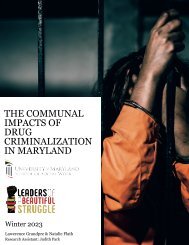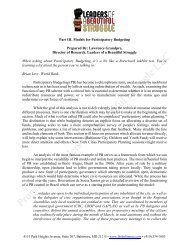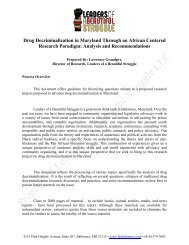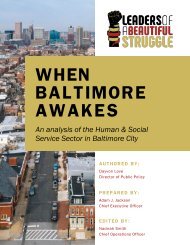Workforce Development Legislation and Practice Literature Review, Maryland, 2007-2017
This document attempts to create an overview of the literature around the legislative and political dynamics around workforce development theory and practice in Maryland through the years 2007 through 2017. This period includes three different gubernatorial regimes, three presidents, a massive shift in federal workforce development policy, and the largest economic contraction in the United States since the great recession. While the tumultuous circumstances this time period encompasses adds an additional layer of complexity to an already diverse state workforce environment, over time general trends can be observed and evaluated
This document attempts to create an overview of the literature around the legislative and political dynamics around workforce development theory and practice in Maryland through the years 2007 through 2017. This period includes three different gubernatorial regimes, three presidents, a massive shift in federal workforce development policy, and the largest economic contraction in the United States since the great recession. While the tumultuous circumstances this time period encompasses adds an additional layer of complexity to an already diverse state workforce environment, over time general trends can be observed and evaluated
You also want an ePaper? Increase the reach of your titles
YUMPU automatically turns print PDFs into web optimized ePapers that Google loves.
eintegrating returning citizens into the workforce. 25<br />
2013<br />
2013 saw the continued development of the state’s policy architecture around workforce development<br />
which can be seen as the work of previous years beginning to culminate in change. HB0227 created the<br />
Employment Advancement Right Now (EARN) program. Through it, industries engage in a competitive<br />
process where they present proposals for collaborative workforce development efforts. The program is<br />
designed to prioritize data-driven approaches to exp<strong>and</strong>ing the skilled workforce to meet the needs of the<br />
industry. Additionally, many of the bills passed related to exp<strong>and</strong>ing educational opportunity to<br />
traditionally excluded demographics, including HB0698, which create a workgroup to study its<br />
entrepreneurial opportunities for individuals who have had experience with the criminal justice system,<br />
HB1012 which established conditional tuition waivers for individuals who have had experience with the<br />
foster care system for state schools.<br />
The literature from this year supports the idea that 2013 was a year for taking stock <strong>and</strong> reflecting on<br />
experience. The Job Opportunities Tasks Force (JOTF) produced two documents attempting to exp<strong>and</strong><br />
workforce development <strong>and</strong> legislative advocacy conversations. First, JOTF published a report relaying<br />
the lessons they have learned engaging in legislative advocacy on behalf of individuals with criminal<br />
records. The report, entitled Advocating for the Successful Reentry of Individuals with Criminal Records,<br />
attempts to outline some of the strategies <strong>and</strong> lessons from the experience JOTF had over the course of<br />
years advocating for policy change to increase access to workforce development <strong>and</strong> employment<br />
opportunity for returning citizens. 26 This is a rare report in the literature which attempts to give some<br />
“how to” advice for institutions seeking to engage in legislative advocacy for people with criminal records,<br />
<strong>and</strong> the report seeks to give examples related to strategy, building coalitions, choosing the scope of your<br />
policy reforms (discussing the relative merits of the “low hanging fruit” approach versus the “going bold”<br />
approach) <strong>and</strong> even the relative value of making “unlikely allies” <strong>and</strong> using state fiscal impact as a<br />
mechanism to generate support for a particular policy. One example of an advocacy strategy relating to<br />
increasing support for workforce development involves a discussion around exp<strong>and</strong>ing the conversation<br />
around SNAP benefits to individuals convicted of drug offenses:<br />
“Many states remain in fiscal crisis <strong>and</strong> proposals that increase revenue or reduce<br />
expenditures are likely to capture the attention of the administration <strong>and</strong> legislators. Like<br />
many states, Maryl<strong>and</strong> opted to ban SNAP benefits (food stamps) for single people <strong>and</strong><br />
noncustodial parents with drug convictions. Previous attempts to change this policy based<br />
on the need for food assistance were ineffective, but the governor’s office became<br />
interested when JOTF, in 2005, explained that lifting the ban would make Maryl<strong>and</strong><br />
25<br />
“Results Based Public Policy Strategies for Promoting <strong>Workforce</strong> Strategies for Reintegrating Ex-Offenders.” Papers, Center<br />
for the Study of Social Policy, Apr. 2012, www.cssp.org/policy/papers/Promoting-<strong>Workforce</strong>-Strategies-for-Reintegrating-Ex-<br />
Offenders.pdf.<br />
26<br />
“Advocating for the Successful Reentry of Individuals with Criminal Records: Lessons Learned from Maryl<strong>and</strong>.” Latest<br />
Publications, Job Opportunity Task Force- Prepared for the Annie E. Casey Foundation, Nov. 2013,<br />
jotf.org/Portals/0/jotf/publications/JOTF%20Lessons%20Learned%20FINAL.pdf.<br />
4151 Park Heights Avenue, Suite 207, Baltimore, MD 21215 • www.lbsbaltimore.com • (410) 374-7683









